As we move further into 2025, WordPress continues to dominate the digital landscape. It remains the undeniable champion of Content Management Systems (CMS), powering an incredible number of websites across the globe.
If you are looking to create a website, grow an existing one, or simply understand the power behind the internet’s most popular platform, diving into the latest WordPress statistics 2025 is essential.
This article will break down why WordPress is so popular and how you can leverage its strengths for your benefit.
The Unstoppable Rise of WordPress
WordPress isn’t just a trend; it’s a fundamental part of the internet. Think about this: nearly half of all websites you visit online use WordPress. This massive presence speaks volumes about its reliability, flexibility, and user-friendliness.
How Many Websites Use WordPress in 2025?
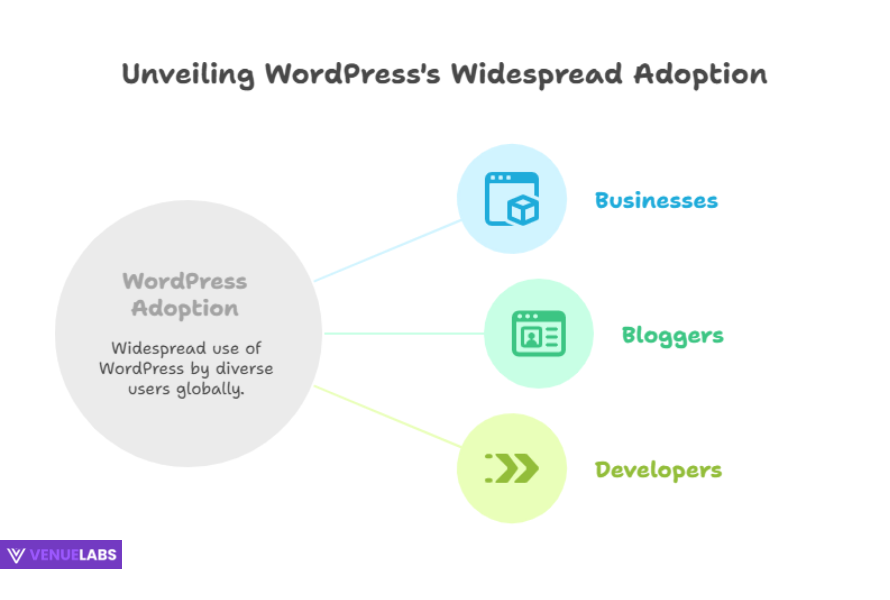
Right now, over 478 million websites actively use WordPress. That’s a staggering figure, highlighting its widespread adoption by businesses, bloggers, and developers. This number continues to grow as more people discover the ease and power of the platform.
Source: WordPress.org
What Percentage of All Websites Use WordPress?
WordPress powers approximately 43.5% of all websites globally. This means it holds nearly half of the entire internet! This incredible market share is a testament to its robust features, extensive customization options, and the vibrant community that supports it.
WordPress Dominates the CMS Market Share
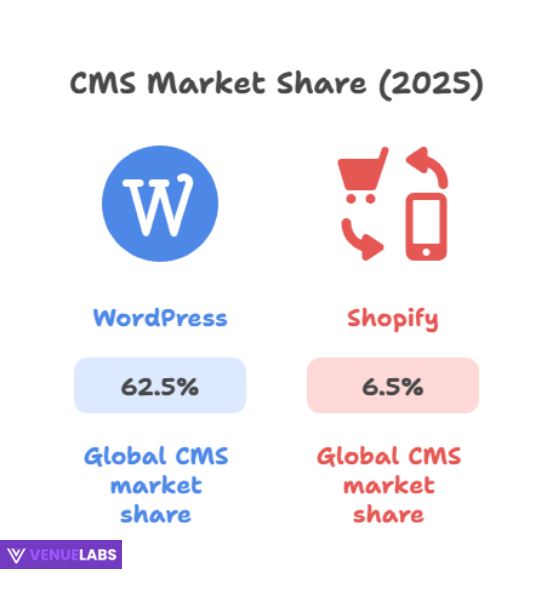
When we talk about Content Management Systems, WordPress isn’t just a leader; it’s a giant. It commands an impressive 62.5% of the global CMS market share. This statistic makes it clear that other CMS platforms are playing catch-up.
Here’s how WordPress stacks up against its closest competitors in the CMS market:
| CMS Platform | Market Share (2025) |
| WordPress | 62.5% |
| Shopify | 6.5% |
| Wix | 4.4% |
| Squarespace | 3.1% |
| Joomla | 2.5% |
| Drupal | 1.5% |
Source: Statista
As you can see, WordPress significantly outpaces its rivals. This dominance stems from its intuitive interface, versatility, and the vast ecosystem of plugins and themes available.
- Also read about: Internet User Statistics
General WordPress Statistics: A Closer Look
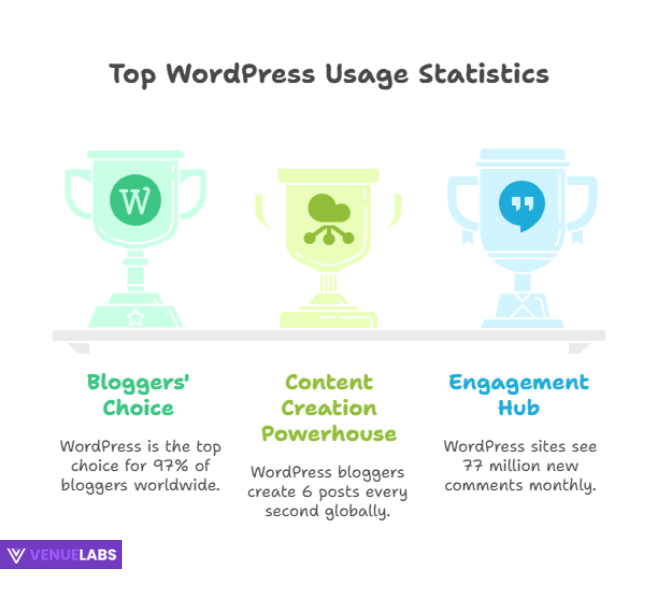
Beyond market share, several other statistics paint a vivid picture of WordPress’s impact:
- Bloggers Love WordPress: A whopping 97% of bloggers choose WordPress as their platform. Its roots as a blogging tool still make it the go-to for content creators worldwide.
- Constant Content Creation: WordPress bloggers create an astounding six posts every second. This translates to over 8.5 billion posts annually!
- Active Engagement: Every month, users post 77 million new comments on WordPress sites, showing a highly interactive and engaged community.
- Decade of Growth: In the past decade, WordPress websites have seen a remarkable 27% growth. This upward trend shows no signs of slowing down.
- Big Names Trust WordPress: Major corporations and media outlets like TechCrunch, CNN, UPS, TED, and Spotify all rely on WordPress.com, demonstrating its capability to handle high-traffic, enterprise-level websites.
WordPress Usage Statistics: More Than Just Blogs
While WordPress started as a blogging platform, it has evolved into a full-fledged CMS. Users utilize its powerful features in various ways:
| Use of WordPress | Percentage of Users |
| CMS Only | 69% |
| Both CMS and Blog | 20% |
| Blog Only | 6% |
These numbers reveal that the majority of users leverage WordPress for comprehensive content management, with a significant portion also integrating blogging functionality.
WordPress has also earned the title of the fastest-growing CMS platform for 11 consecutive years, showing its consistent ability to attract new users and adapt to changing web development needs. Even among the top 1,000 sites, 30.3% use WordPress, proving its capability for large-scale operations.
WordPress Revenue and Marketplace Insights
The WordPress ecosystem supports a thriving economy. Its ease of use makes it a preferred choice for businesses of all sizes, contributing to a significant share of the internet’s commercial activity.
- Overall Website Market Share: WordPress commands 43% of the market share of all websites on the internet.
- Growth Over the Last Decade: WordPress has grown by an impressive 27% in the past ten years, indicating sustained relevance and increasing adoption.
- Top 100k and 10k Sites: Among the top 100,000 sites, WordPress holds a 35.94% share, and among the top 10,000 sites, it owns 38.03%. This shows its strong presence even in the most competitive segments of the web.
WordPress Traffic Statistics: A Global Audience
WordPress websites attract immense traffic, serving millions of users daily.
- Massive Monthly Views: Approximately 409 million people view over 20 billion pages monthly through WordPress. This highlights the platform’s ability to handle enormous traffic volumes.
- New Content Flow: Users publish 70 million new posts monthly via the CMS.
- Engaged Community: There are 77 million new comments posted on WordPress websites each month.
- Unique Visitors: WordPress records around 163 million unique visitors monthly.
WordPress Across the Globe
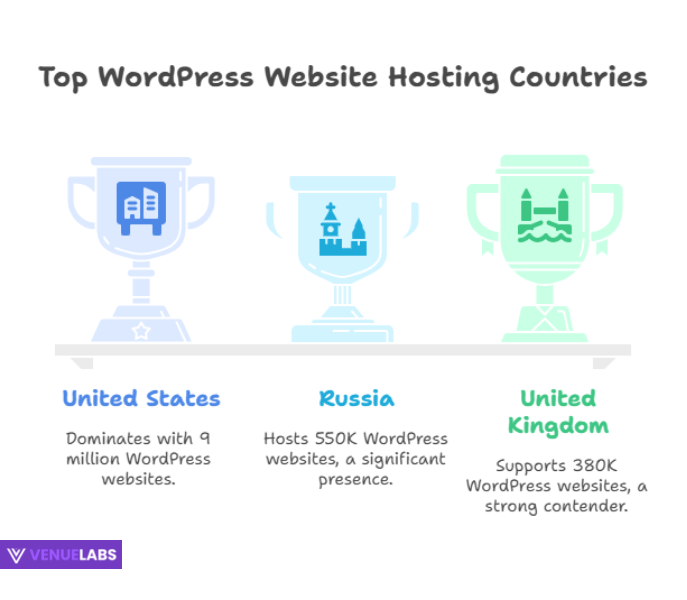
WordPress is a truly global phenomenon, used in virtually every country. While sites exist worldwide, some nations show particularly high adoption rates.
- Global Reach: WordPress is actively used in more than 178 countries.
- Language Accessibility: It’s available in over 60 different languages, making it accessible to a diverse international audience.
- United States Leads: The United States boasts the highest number of WordPress sites, with approximately 9 million.
Here are the top countries with the most WordPress websites:
| Rank | Country | WordPress Websites |
| 1 | United States | 9 Million |
| 2 | Russia | 550K |
| 3 | United Kingdom | 380K |
| 4 | Iran | 280K |
| 5 | India | 275K |
| 6 | Canada | 222K |
| 7 | Australia | 161K |
| 8 | Brazil | 123K |
| 9 | Vietnam | 114K |
| 10 | Germany | 10K |
Looking at active WordPress websites reveals similar patterns:
| Country | Number Of Active Websites |
| United States | 3,777,615 |
| Germany | 1,765,106 |
| United Kingdom | 1,346,012 |
| Brazil | 1,048,503 |
| France | 975,972 |
| Netherlands | 895,373 |
| Italy | 870,199 |
| Russia | 739,255 |
| India | 724,223 |
| Japan | 710,408 |
WordPress Version Statistics: Always Evolving
WordPress constantly improves, releasing major updates several times a year. These updates bring new features, security enhancements, and performance improvements.
- Latest Version Dominates: WordPress Version 6.x is now used by a significant majority, with 53.8% of websites running on it. Specifically, Version 6.1 (and its minor updates) sees the highest adoption, with 54.3% of WordPress websites using it.
- Consistent Updates: WordPress typically releases 2 to 3 major updates per year, ensuring the platform remains modern and secure.
Here’s a look at the usage of different WordPress versions:
| Version | Percentage Of Users |
| Version 2.x | <0.1 % |
| Version 3.x | 0.4% |
| Version 4.x | 6.6% |
| Version 5.x | 39.1% |
| Version 6.x | 53.8% |
WordPress Plugin Statistics: Extending Functionality
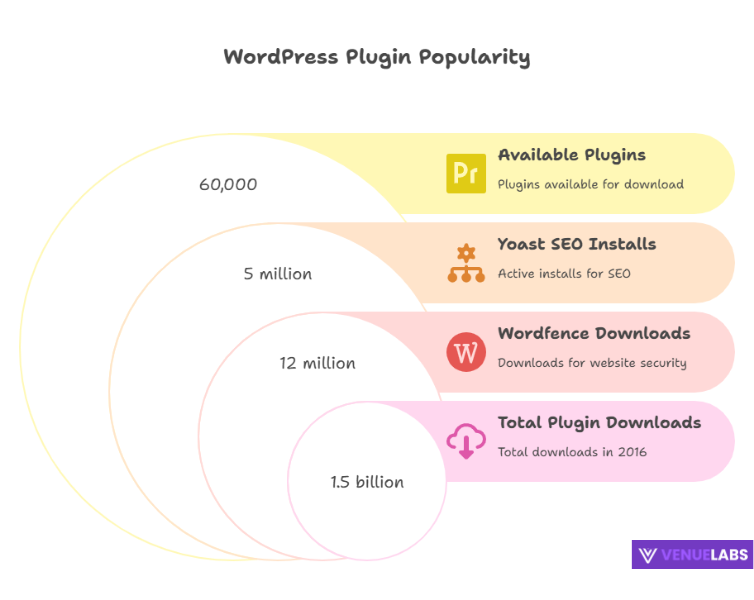
One of WordPress’s greatest strengths is its extensibility through plugins. You can find a plugin for almost any functionality you can imagine.
- Vast Free Plugin Library: The official WordPress.org directory offers around 60,000 free plugins.
- Billions of Downloads: In 2016 alone, there were 1.5 billion plugin downloads from WordPress.org, a number that continues to grow.
- SEO is Key: Yoast SEO stands out as the most popular plugin, with over 5 million active installations and over 463 million downloads. It helps websites rank higher in search engines.
- Security Matters: The Wordfence security plugin has seen more than 12 million downloads, highlighting the importance users place on website security.
Popular Plugin Categories and Top Choices:
WordPress users frequently need plugins for specific functions like SEO, speed optimization, page building, and security.
SEO Plugins:
| Plugin | Active Installations |
| Yoast SEO | More than 5 million |
| All-in-One SEO Pack | More than 2 million |
| RankMath | More than 800,000 |
Speed Plugins:
| Plugin | Active Installations |
| JetPack | More than 5 million |
| WP-Optimize | More than 1 million |
| NitroPack | More than 60,000 |
Page Builders:
| Plugin | Active Installations |
| Elementor | More than 5 million |
| SiteOrigin Builder | More than 1 million |
| Beaver Builder | More than 300,000 |
Contact Form Plugins:
| Plugin | Active Installations |
| Contact Form 7 | More than 5 million |
| WP Forms | More than 4 million |
| Ninja Forms | More than 1 million |
Security Plugins:
| Plugin | Installations |
| Wordfence Security | More than 4 million |
| iThemes Security | More than 1 million |
| Sucuri Security | More than 800,000 |
Backup Plugins:
| Plugin | Active Installations |
| UpdraftPlus | More than 3 million |
| BackWPup | More than 700,000 |
| VaultPress (Jetpack Backup) | More than 60,000 |
- Also read about: Best WordPress CRM 2025: For Small Business
WordPress Theme Statistics: Designing Your Digital Space
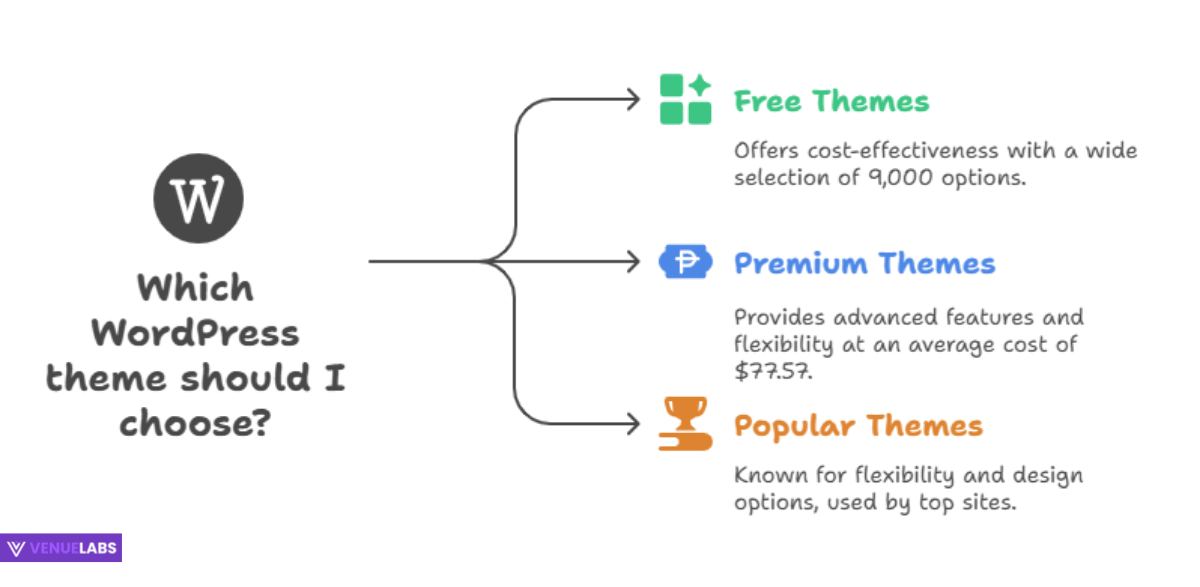
Themes define the look and feel of your WordPress website. The vast selection allows for endless design possibilities.
- Abundant Theme Options: WordPress offers around 31,000 themes, encompassing both free and premium options.
- Free Theme Repository: Over 9,000 free themes are available in the WordPress theme repository.
- Premium Theme Investment: The average price for a premium WordPress theme is reported to be $77.57, reflecting the value and advanced features they offer.
- Popular Themes: Divi and Astra are two of the most popular active themes used by the top 1 million sites, known for their flexibility and design options.
Here are some of the most used themes:
| Theme | Percentage Of WordPress Sites |
| Choices | 13% |
| Divi | 7% |
| Astra | 5% |
| Popper | 5% |
| Avada | 3% |
| GeneratePress | 3% |
| Others | 64% |
WordPress Security Statistics: Protecting Your Website
Security is paramount for any website owner. WordPress, with its open-source nature, constantly works to enhance its security, often through dedicated plugins and community efforts.
- Constant Threat Landscape: Over 90,000 attacks occur on WordPress sites every minute, underscoring the constant need for vigilance.
- Brute Force Attacks: Brute force attacks are responsible for 16.1% of attacks on WordPress websites, where attackers try to guess login credentials.
- Plugin Vulnerabilities are Key: More than 90% of WordPress vulnerabilities originate from plugins. This highlights the importance of choosing reputable plugins and keeping them updated.
- Outdated Software Risk: A significant 39% of hacked WordPress websites in 2017 were running an outdated version of the WordPress software, emphasizing the critical need for updates.
- Weak Passwords: 8% of WordPress websites were hacked due to weak passwords. Always use strong, unique passwords!
Here are the top vulnerabilities by type on WordPress:
| Vulnerability Type | Percentage Of Vulnerability |
| XSS | 52% |
| File Upload | 7% |
| Access Controls | 12% |
| SQL Injection | 13% |
| CSRF | 16% |
WordPress Community: The Power of Open Source
WordPress thrives because of its global community of contributors. This open-source nature means thousands of individuals contribute to its development, translation, and support.
- Global Translation Efforts: The WordPress translation community has fully translated the software into 56 languages and partially into dozens more.
- Active User Groups: Dozens of WordPress groups on platforms like Facebook boast thousands of members, offering support, advice, and networking opportunities.
- WordCamp Events: In 2017 alone, WordPress communities organized 128 WordCamp events in 48 countries, bringing together users and developers worldwide.
How Much Do People Make With WordPress?
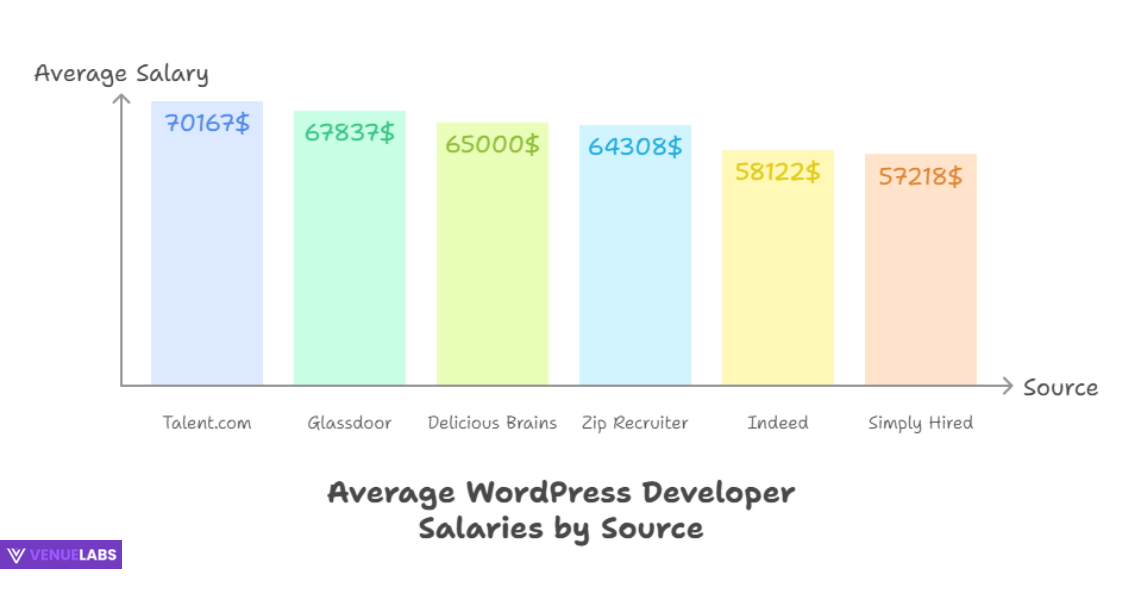
WordPress offers significant income opportunities for those with the right skills. From freelance development to full-time positions, the demand for WordPress expertise is high. Here’s a snapshot of average WordPress developer salaries:
| Source | Minimum Salary | Average Salary | Maximum Salary |
| Talent.com | $55,000 | $70,167 | $105,000 |
| Glassdoor | $39,000 | $67,837 | $118,000 |
| Delicious Brains | $45,000 | $65,000 | $150,000 |
| Zip Recruiter | $24,000 | $64,308 | $106,500 |
| Indeed | N/A | $58,122 | N/A |
| Simply Hired | $28,235 | $57,218 | $115,948 |
WordPress Trends for 2025: What’s Next?
WordPress continues to evolve, adapting to new technologies and user demands. Here are some key trends shaping its future:
- E-commerce Dominance with WooCommerce: Most small businesses use WordPress as an e-commerce tool. WooCommerce, the leading e-commerce plugin for WordPress, will continue to play a crucial role in integrating payment gateways and managing online stores. It already powers 25% of all e-commerce websites across the internet.
- Intuitive Drag-and-Drop Page Builders: Tools like Elementor will make website design even more accessible and convenient, allowing users to create stunning layouts without coding.
- User-Friendly Navigation Structures: Developers are focusing on creating new, highly intuitive navigational structures that enhance user experience.
- Mobile-First Approach: The increase in mobile-friendly websites will continue across all niches. WordPress themes and plugins are designed to be responsive, ensuring optimal viewing on any device.
- Gutenberg and Full Site Editing (FSE): WordPress will continue to refine and build out its Gutenberg block editor and Full Site Editing (FSE) features, offering more comprehensive control over site design directly within the editor.
- Anticipated Market Share Growth: Experts estimate that around 50% of all websites will be powered by WordPress in the near future, indicating continued growth.
WordPress’s Biggest Competitors: A Closer Look
While WordPress dominates, it’s important to understand its competitors and their niches.
- Shopify: As the second most popular CMS platform, Shopify is specifically built for online stores. It’s more focused and beginner-friendly for e-commerce, though it comes with a subscription cost unlike free WordPress.
- Wix and Squarespace: These site-building platforms target absolute beginners, offering quick and easy website launches. However, they often lack the flexibility and scalability of WordPress, especially for larger or more complex sites.
- Joomla and Drupal: These are older, open-source CMS platforms similar to WordPress. However, they have a steeper learning curve and smaller communities, leading to a decline in their market share, with many users migrating to WordPress.
Why is WordPress So Popular? (Insights from Quora/Reddit)
Beyond the numbers, users on platforms like Quora and Reddit frequently discuss why they choose WordPress. The common themes emerging from these discussions include:
- Cost-Effectiveness: While you pay for hosting, the WordPress software itself is free. This makes it highly attractive for startups and small businesses.
- Scalability: Users often praise WordPress’s ability to grow with their needs, from a simple blog to a complex e-commerce site.
- Massive Community Support: If you encounter a problem, chances are someone else has already solved it, and you can find help easily through forums, groups, or tutorials.
- Flexibility and Customization: The sheer number of plugins and themes means you can create almost any type of website imaginable. Users love the ability to tailor their sites precisely to their vision.
- SEO Friendliness: With powerful SEO plugins, WordPress makes it easier to optimize websites for search engines, which is crucial for online visibility.
- Open Source Philosophy: Many appreciate the open-source nature, feeling they have more control and are part of a larger, collaborative project.
- Ownership and Control: Unlike proprietary platforms, with WordPress, you own your data and have complete control over your website.
FAQs About WordPress Statistics
1. Why is WordPress more popular than other CMS platforms?
WordPress stands out for its ease of use, flexibility, and scalability. Whether you’re a beginner or building a complex site, it adapts easily. Its vast plugin and theme ecosystem, along with strong community support, makes it the go-to CMS for many.
2. How do WordPress's plugin and theme offerings compare?
WordPress offers unmatched variety—around 60,000 plugins and 31,000 themes. This far exceeds platforms like Wix or Shopify, allowing deep customization and functionality for all types of websites.
3. What are the main security concerns for WordPress users?
Most WordPress vulnerabilities come from plugins (90%) and outdated software (39%). Weak passwords cause 8% of hacks. To stay secure, users should keep everything updated, choose trusted plugins, and use strong login credentials.
4. How has WordPress’s market share changed over the last decade?
WordPress grew from 54.3% to 64.3% market share among CMS platforms (2012–2022) and powers 43% of all websites. Its steady rise suggests it will remain the leading CMS, especially for flexible and large-scale sites.
5. What trends should WordPress users watch in 2025?
Key trends include the rise of WooCommerce, mobile-first design, drag-and-drop builders, and enhanced Gutenberg features. Full Site Editing (FSE) is also making WordPress more visual and beginner-friendly.
Also Read:
- Google Searches Statistics
- Mobile Internet Traffic Statistics
- Google Ads Statistics
- Tumblr Statistics
- eLearning Statistics
Conclusion:
WordPress truly remains the leading content management system, powering over 43.5% of all websites and holding a remarkable 62.5% of the CMS market share in 2025.
This article has highlighted its dominance across various metrics – from the sheer number of websites it supports to its vibrant community and the vast ecosystem of plugins and themes.
Its adaptability across different website types, from personal blogs to large-scale e-commerce platforms, and its capacity to meet the ever-changing needs of website owners and developers, underscore its enduring appeal.
For anyone looking to build a robust, scalable, and customizable online presence, WordPress offers an unparalleled solution. Its continuous evolution, robust security measures, and strong community support ensure that it will remain at the forefront of web development for years to come.
Understanding these WordPress statistics 2025 empowers you to make informed decisions and harness the full potential of the internet’s most popular platform.
